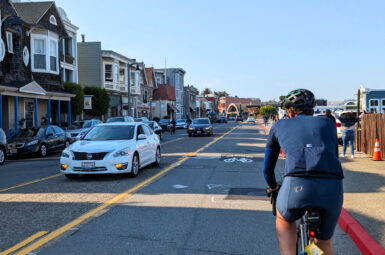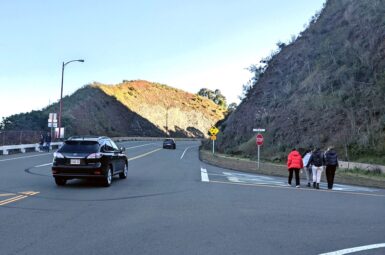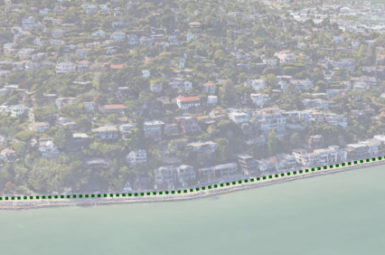MCBC Guest Post Larkspur Ferry Terminal – Planning for More Driving or Less?
Author: Matthew Hartzell, Director of Planning at WTB-TAM, an advocacy group that promotes sustainable mobility in Marin County
In operation since 1976, the Larkspur Ferry is an important part of Marin’s multi-modal transportation system, providing a fast and scenic connection to San Francisco. The ferry is popular with bicyclists, who can either take their bicycles aboard the ferry for the trip across the bay, or park them within the ferry terminal secured perimeter.
Although ridership has decreased since the pandemic, the ferry’s operator — the Golden Gate Bridge, Highway and Transportation District (known as the GGBHTD or the “District”) — forecasts that over the next decade ridership will surpass pre-pandemic levels.
A PARKING GARAGE TO ENCOURAGE PUBLIC TRANSPORTATION USE?
The District has begun the environmental review process on a project to expand the ferry fleet and construct a three-story parking garage to accommodate the forecast increase in ridership. Two locations are being studied for the parking garage: the main parking lot and the auxiliary parking lot (currently parking for the Larkspur SMART station).
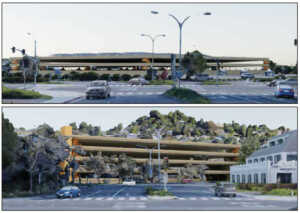
Renderings by Jacobs Engineering of the proposed parking garage on the main parking lot (above) and auxiliary lot (below)
The District will hold a Open House seeking input from the public on Tuesday May 14th from 5:00 to 7:00 pm at the Drakes Landing Community Room, 300 Drakes Landing Road in Greenbrae. MCBC members are encouraged to attend and provide feedback.
The District says that the garage is needed because prior to the pandemic, the existing parking lots (with more than 2,000 spaces) were filled to capacity every day, forcing potential ferry riders to drive to San Francisco instead. It is laudable that the District wants to dissuade people from driving to the City and make it easier to access public transportation. But there are better ways to achieve these goals. Additional parking will likely induce more driving. While those additional car trips to the ferry may reduce traffic on the Golden Gate Bridge, they will increase traffic in the vicinity of the ferry terminal, already one of the most congested areas in Marin County.
FIRST-AND-LAST MILE PATHWAY CONNECTIONS
Some of the solutions to the Larkspur Ferry Terminal’s first-and-last mile problem are already in place. New safe-and-separated pathways that did not exist a few years ago when the parking lot was last filling up now connect to the ferry from origins both north and south. Residents of San Rafael can travel by active modes along a continuous pathway through the Cal Park Hill to the ferry. Those in Larkspur, Corte Madera, and points south have at their disposal new pathways south of and across Corte Madera Creek. Meanwhile, residents of Greenbrae, Kentfield, and the Ross Valley can access the ferry by the Corte Madera Creek Path.
There are other gaps that, when complete, will further optimize the first-and-last mile pathway network serving the ferry. There is an all-ages-and-abilities pathway planned along the old railroad right-of-way behind Trader Joe’s that avoids a busy and dangerous stretch of Redwood Highway. New pathways and protected bike lanes are planned for Bellam Boulevard, Lucky Drive, Nellen Avenue, and Wornum Drive. And the County won a federal earmark to extend the pathway on East Sir Francis Drake Boulevard to Andersen Drive.
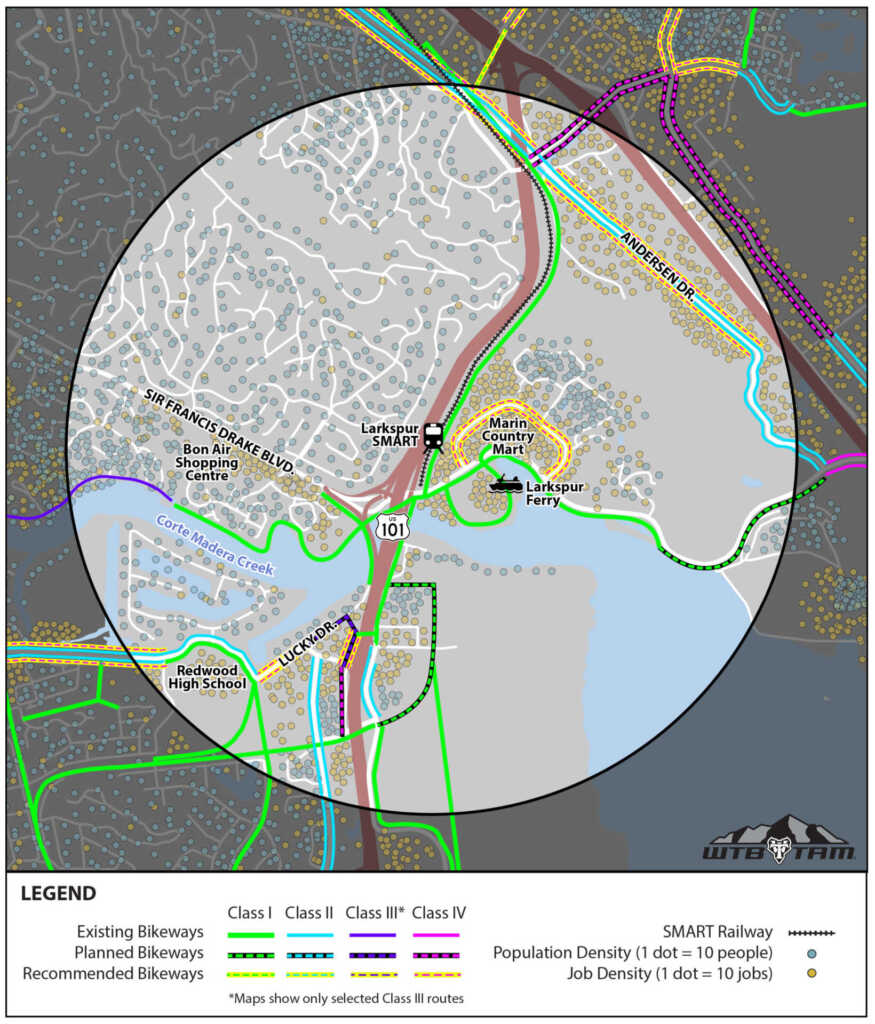
Map of existing, planned, and recommended bikeways in the 1-mile radius of the Larkspur Ferry Terminal
Although the above pathway gap closure projects are being managed by other agencies, they all have the potential to help people access the ferry and shift ferry-bound trips from cars to active modes. A survey conducted by the District shows that nearly half of Larkspur ferry riders come from the communities immediately surrounding the ferry terminal, a realistic distance to cover by bicycle, easier still by e-bike.
BIKESHARE AND BIKE PARKING
Initiative #4 in the District’s current Draft Strategic Plan calls for improving bicycle parking at the District’s ferry terminals. Marin County is currently rolling out a new bikeshare system that will include bikeshare hubs at the Larkspur Ferry Terminal and nearby activity centers. However, the planned network will be spread thin, with a limited number of shared bikes available to ferry riders. The District could supplement that system with additional bikeshare capacity of its own.
NON-BICYCLE SOLUTIONS
Initiative #16 in the Draft Strategic Plan describes “green transportation options for accessing the ferry” under the umbrella of “Sustainability and Climate Responsibility.” SMART is doing its part to help train riders connect more seamlessly to the ferry by coordinating schedules and launching a new SMART Connect shuttle service between Larkspur SMART station and the Larkspur Ferry.
District-operated feeder buses are another logical alternative for riders who for whatever reason can’t ride a bike to the ferry. The District successfully operated feeder buses for many years before discontinuing them due to poor utilization. With better outreach and route optimization, those feeder buses could be brought back with better results.
Pricing incentives could play a major role in promoting multi-modal access to the ferry and reducing demand for parking. Riders accessing the ferry terminal by transit, bicycle, foot, or carpool could be rewarded with discounted ferry tickets. Those who continue to park their single-occupancy cars in the one of the existing 2,000 parking spaces could be charged a higher amount that better encapsulates the value of this prime waterfront land than the current parking fee ($2 all-day on weekdays; free on weekends).
Speaking of prime waterfront land, Initiative #18 in the Draft Strategic Plan speaks of building housing on District property. This aligns with the City of Larkspur’s Housing Element, which identifies the ferry parking lots and surrounding area as potential housing sites to meet its state housing mandates. Housing would be a far more efficient use of the District’s land. In addition to being the very definition of “Transit-Oriented Development,” it would help the District generate new ferry riders who don’t need to drive to or park their cars at the ferry.
Have thoughts about access to the ferry and the necessity of building a three-story parking garage to accommodate more cars? Come to the Open House on May 14th and express your views (see details above). Or, submit written comments to LFEP@goldengate.org and districtsecretary@goldengate.org.
members make it happen
Supporters like you, who speak out for safer places to bike and give to MCBC, make projects like these possible. Thank you! Want to support this work? Give here. We’re working hard to ensure that there is always a full pipeline of projects in development so we can keep making Marin more bikeable every year.
